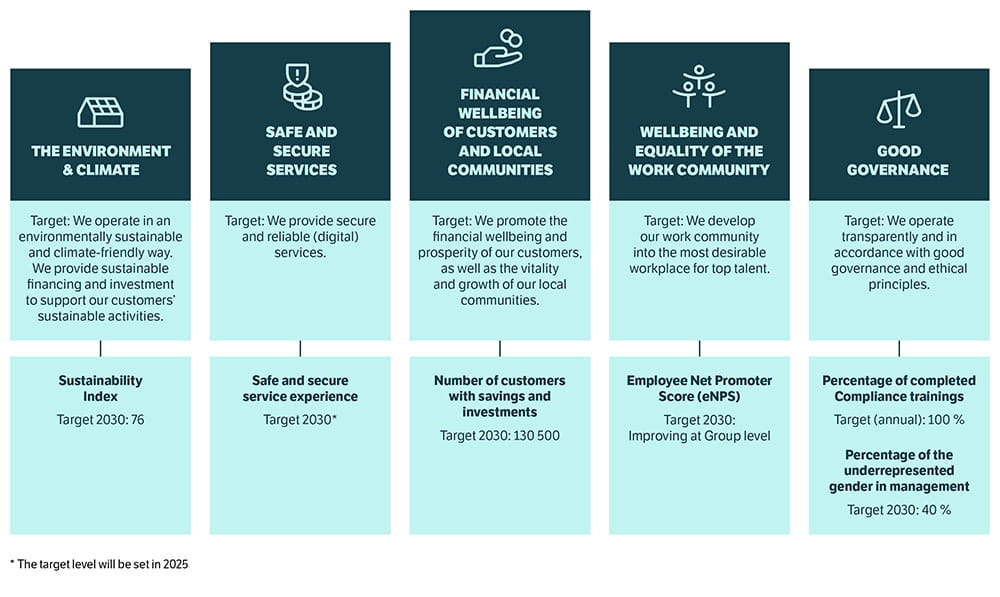Sustainability strategy
Our sustainability strategy aims at increasing the positive and decreasing the negative impacts on environment and society among others through our products, services, processes and partnerships.
As a responsible actor in the finance industry, we recognize that our operations have versatile impacts on our stakeholders and surrounding world. Our sustainability strategy aims at increasing the positive and decreasing the negative impacts on environment and society among others through our products, services, processes and partnerships.
Sustainability is an integral part of all operations, management and decision-making within the Savings Banks Group. As a result of the materiality analysis, we have selected the following sustainability priorities in our sustainability strategy revised in autumn 2024: Financial wellbeing of customers and local communities; Safe and secure service experience; Wellbeing & equality in the work community; Environment & climate; and Good governance. These five main themes form the basis of our sustainability strategy, which complements our Group strategy, and of our set of sustainability-related targets.

We have set goals for all three dimensions of sustainability: environmental sustainability, social responsibility and governance. In environmental sustainability, our goals are linked to the climate, and we will be setting emission reduction targets in 2025. In terms of social responsibility, we aim to promote the financial wellbeing and prosperity of our customers and the vitality and growth of our local communities, to provide secure and reliable (digital) services and to be the most desirable workplace for top talent. In terms of governance, our goal is to operate in a transparent manner and in accordance with good governance and ethical principles.
The UN member states have agreed on Sustainable Development Goals (SDGs) and an action programme that serves as a guideline for global development efforts until 2030. There are 17 SDGs in total. The themes of our sustainability strategy support the following: 12 (responsible consumption), 8 (decent work and economic growth), 9 (sustainable industry, innovation and infrastructure), 16 (peace, justice and good governance) and 13 (climate action).
The themes of the Savings Banks Group’s sustainability strategy are based on a double materiality assessment. The purpose of the assessment is to identify the key aspects of sustainability for the Savings Banks Group and its stakeholders. Materiality is assessed through negative and positive impacts as well as risks and opportunities.
The materiality analysis we conducted in 2024 is based on an internal mapping of the operating environment and scientific articles, stakeholder surveys and interviews, and management workshops in which the Savings Banks Group’s environmental, social and stakeholder impacts, as well as the financial risks and opportunities associated with sustainability issues were assessed.
We conducted stakeholder surveys with various stakeholders, including the Savings Banks Group’s own employees, the Management Team, the Board of Directors, customers, investors and partners. We also interviewed representatives of our affected stakeholders. The interviewed stakeholders represented the Savings Banks Group’s Management Team, Board of Directors, partners, customers, industry associations and NGOs representing vulnerable groups. On the basis of the views expressed in the mapping of the operating environment, the interviews and surveys, we prioritised the material sustainability matters in our management workshops.